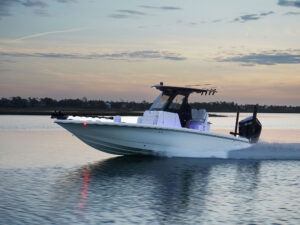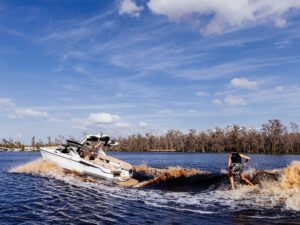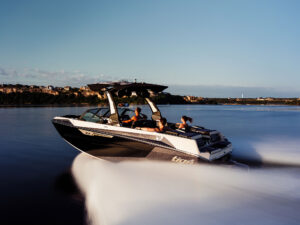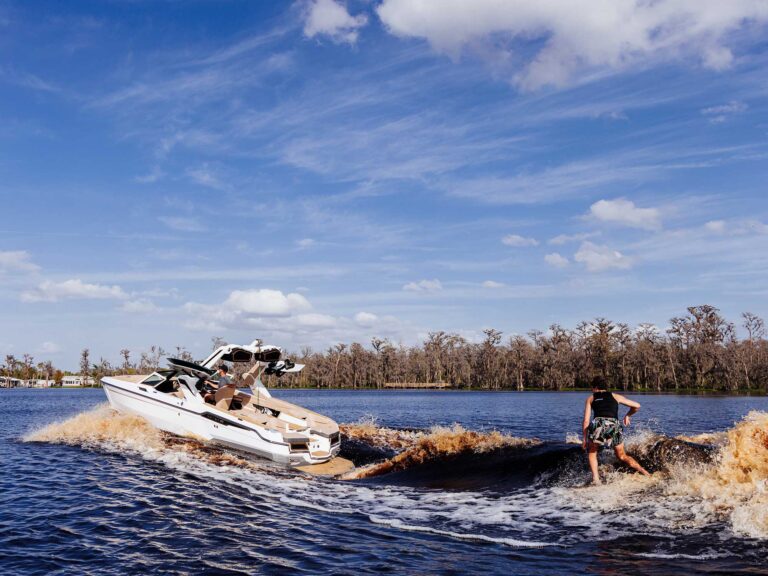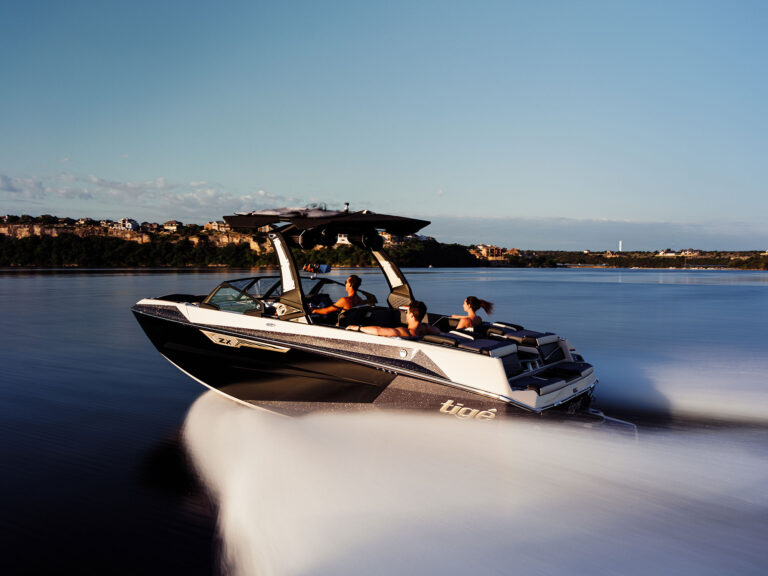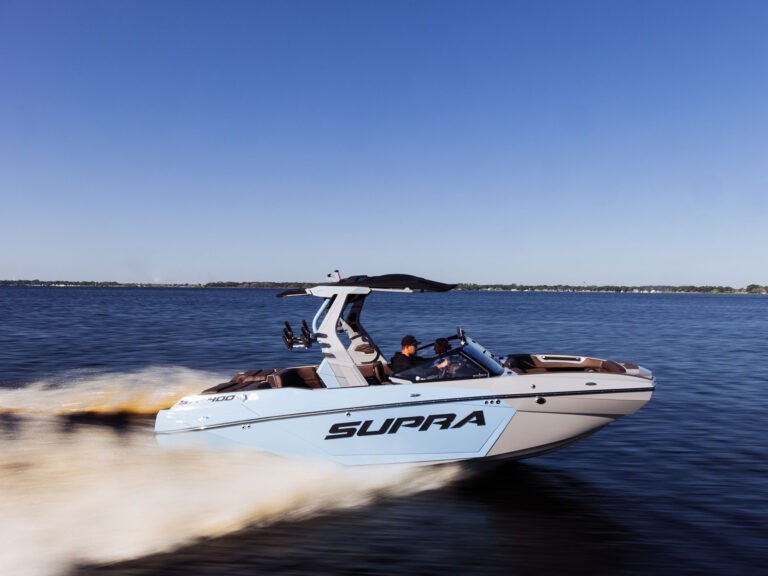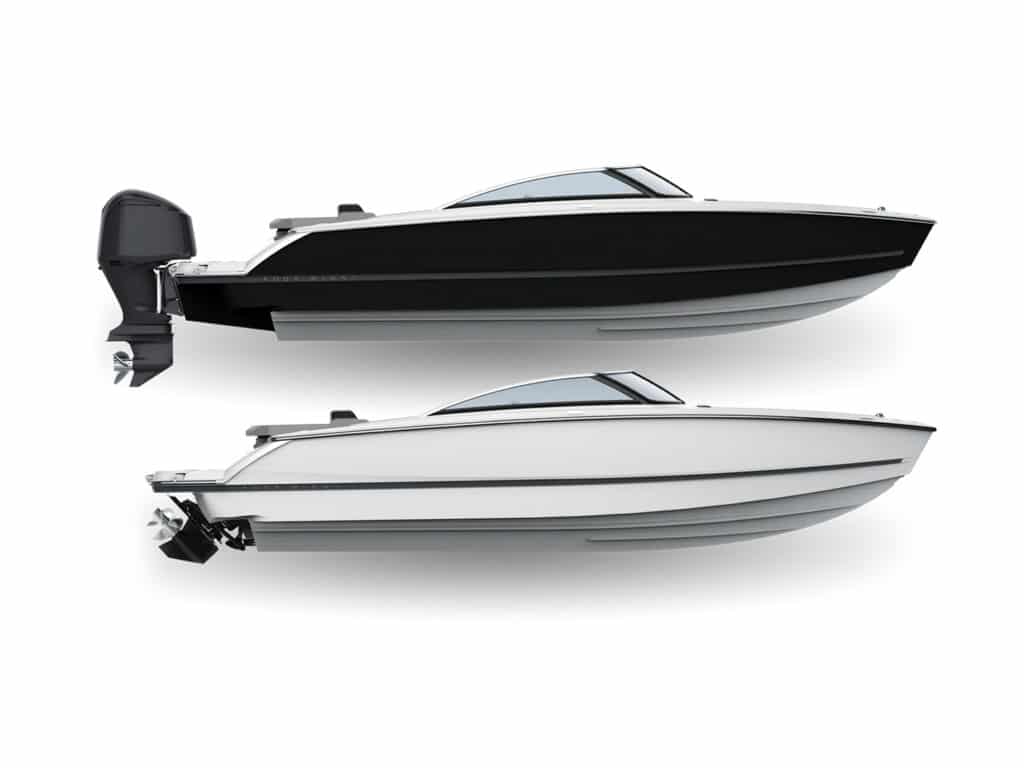
If you are ordering a new runabout this season, you’ll likely have dozens of decisions to make, from the hull color to options like those red-blue-green LED-infused drink holders. However, the most impactful choice on your build-a-boat checklist might be under the heading of power. To wit: outboard or sterndrive? The type of power you choose will influence the personality of the boat, how you can use the boat, and how much you enjoy the boat. The choice between outboard and sterndrive power can also be a big factor in the initial purchase price of a new boat. The new Four Winns H4 models present us with a fresh chance to consider these two power options.
Power Options
Outboard power has been ascendant in the runabout/deck-boat category for a number of seasons. There is still regional demand for sterndrive power north of the Atlanta market, and builders apparently can’t give away an outboard-powered runabout in Canada. The preference for outboard power in coastal markets seems to influence that choice in southern states. With this in mind, the 23-foot-11-inch H4 model is offered in both outboard and sterndrive flavors.
Outboard options for the H4 include Yamaha and Mercury products from 200 to 300 hp. Sterndrive options include twin-prop Mercury MerCruiser and Volvo Penta packages from 250 to 350 hp. For this comparison, we went with bestselling midrange power that would produce equivalent performance: a 250 hp Mercury Verado 250 and the 280 hp Volvo Penta V6-280C Duoprop, each a state-of-the-art powertrain in its propulsion category.
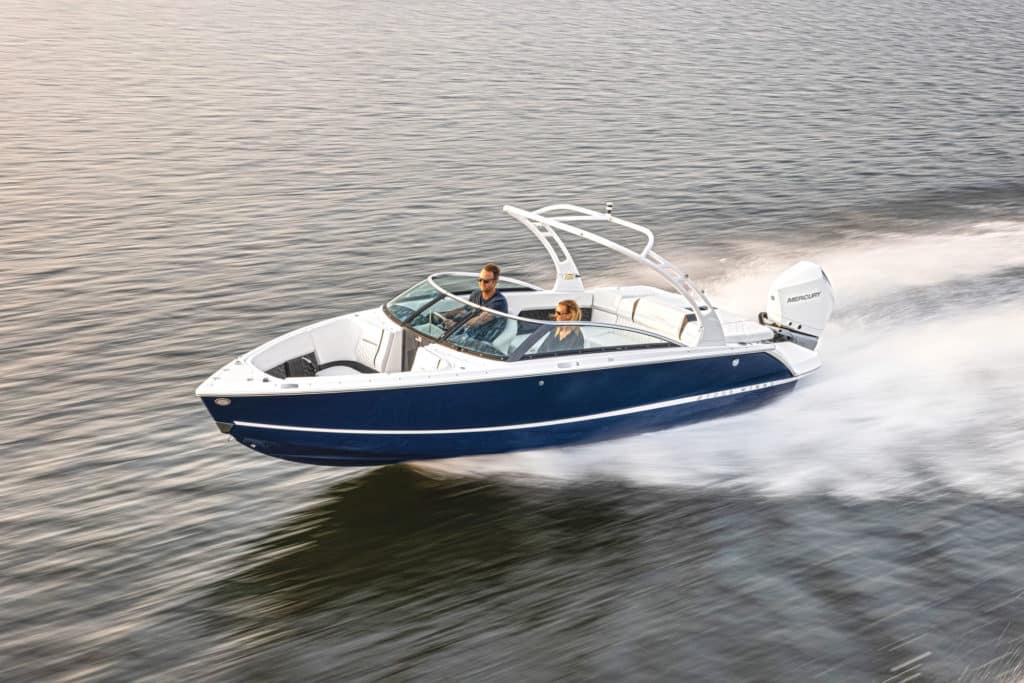
The Mercury Verado 250 is a 4.6-liter V-8 equipped with the vibration-damping Advanced MidSection (AMS), power steering, and standard digital throttle and shift (DTS) controls. It is compatible with an entire suite of Mercury SmartCraft digital technologies and VesselView displays. A highlight on this motor is the Top Cowl Service Door, which provides easy access to the engine-oil dipstick, the oil fill and basic maintenance info, all without removing the cowl—no more excuses for not checking the oil. Another nice feature is the lifetime maintenance-free valve train. It weighs 600 pounds for a power-to-weight ratio of 0.42.
The Volvo Penta V6-280C Duoprop is based on an EcoTec3 LV1 4.3-liter V-6 sourced from General Motors and comes loaded with bells and whistles. The block, heads and oil pan are lightweight aluminum. Continuously variable valve timing broadens the powerband across the rpm range. Direct fuel injection precisely meters fuel directly into the cylinders to optimize combustion over a broad range of conditions. The standard closed-cooling system makes winterization a DIY option for many boaters thanks to Easy Drain, which quickly purges seawater from the heat exchanger system. The DPS Duoprop drive, of course, puts a pair of contra-rotating stainless-steel props in the water for added control in forward and reverse. It weighs 908 pounds for a power-to-weight ratio of 0.31.
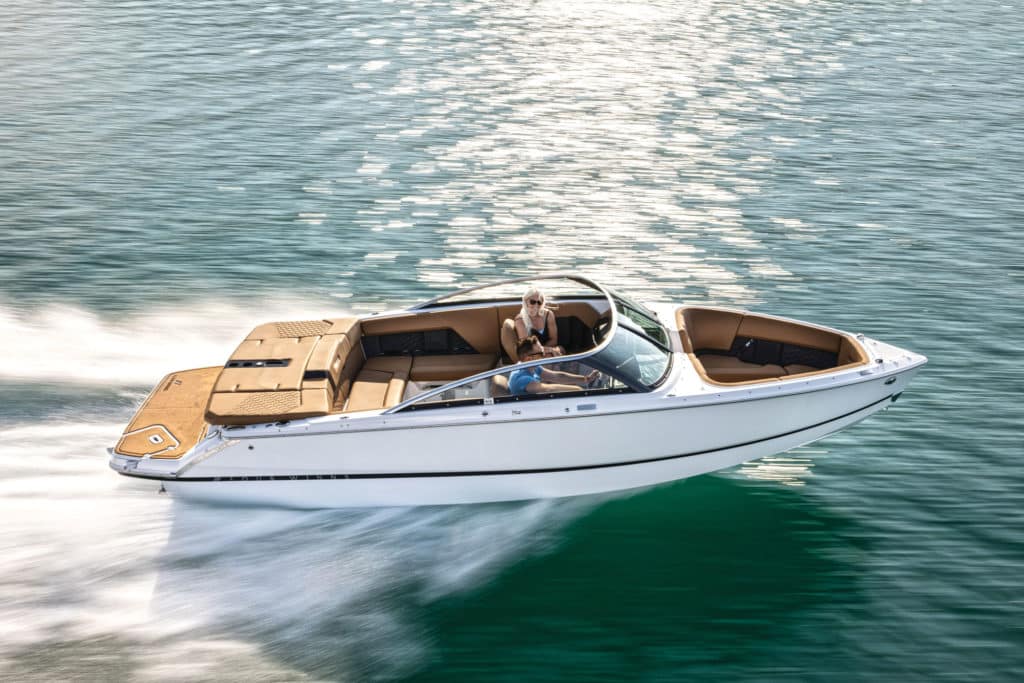
Cost Comparison
The Mercury Verado 250 power option costs a significant $9,073 more than the Volvo Penta V6-280 on the Four Winns price list. To put it another way, the Mercury outboard increases the base price by a little more than 9 percent over the equivalent Volvo Penta option. With $9,000, you could buy a lot of gas or add some sweet options to a new H4. Note that on the Four Winns price sheet, a Yamaha F250 with digital control is $1,800 more expensive than the Mercury Verado 250, and the 250 hp MerCruiser 4.5L V-6 and Bravo Three option is about $3,200 less than the Volvo Penta V6-280. So, the higher price is an outboard thing, not a brand issue.
Economy
In each of our test situations, the sterndrive-powered H4 delivered better fuel economy than the outboard model. The sterndrive achieved its best cruising economy of 4.5 mpg at 3,000 rpm, 9.9 percent more efficient than the outboard, but 6.2 mph slower. Because these engines have different rpm ranges, we also measured economy at specific boat speeds and, again, the sterndrive was more economical—by 8 percent at 25 mph and by almost 15 percent at 35 mph. At 35 mph, we noted 3.9 mpg for the sterndrive boat and 3.4 mpg for the outboard, so in absolute numbers, there’s not a huge difference, but over the course of a season, greater fuel costs for the outboard will add up.
Performance
The outboard-powered boat was faster than the sterndrive. At 51.1 mph, the outboard was 3.5 mph faster than the sterndrive. It’s always fun to measure top speed, but we think acceleration is really more important for most family boaters. Testing with a heavy load, the outboard planed off about a second faster than the sterndrive, and it was more than 2 seconds faster from zero to 20 mph, a big seat-of-the-pants difference from the helm. Despite the added stern lift that the Duoprop propellers should provide, we noted more bow rise on acceleration in the sterndrive-powered boat. In the outboard, we never lost sight of the horizon.
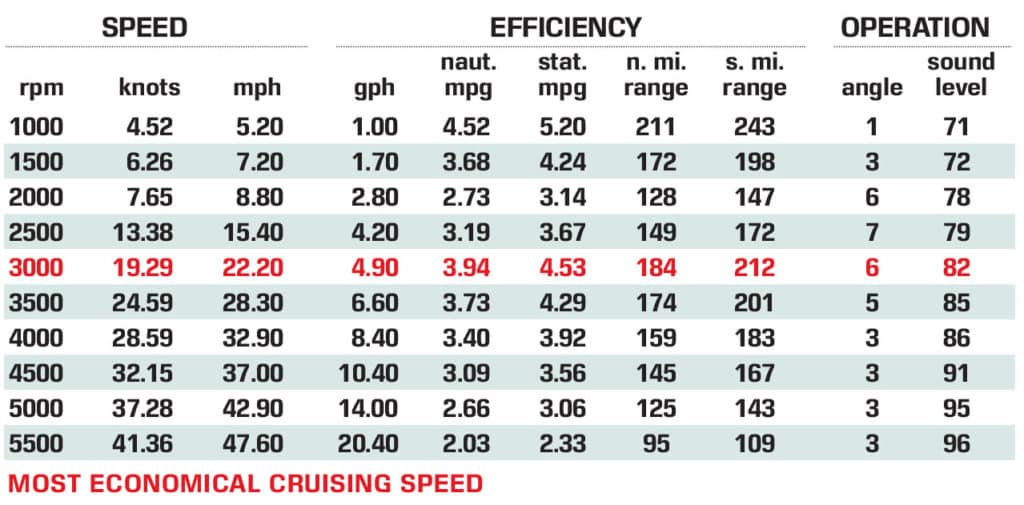
Both boats handled well. The Duoprop drive can make pretty aggressive turns without trimming down—the twin props really bite the water. Those contra-rotating props also offer great thrust and control around the dock. Rigged with a four-blade Mercury Revolution 4 propeller, the outboard also made smart turns with ease, although we did trim down a bit if we started to detect a little slippage.
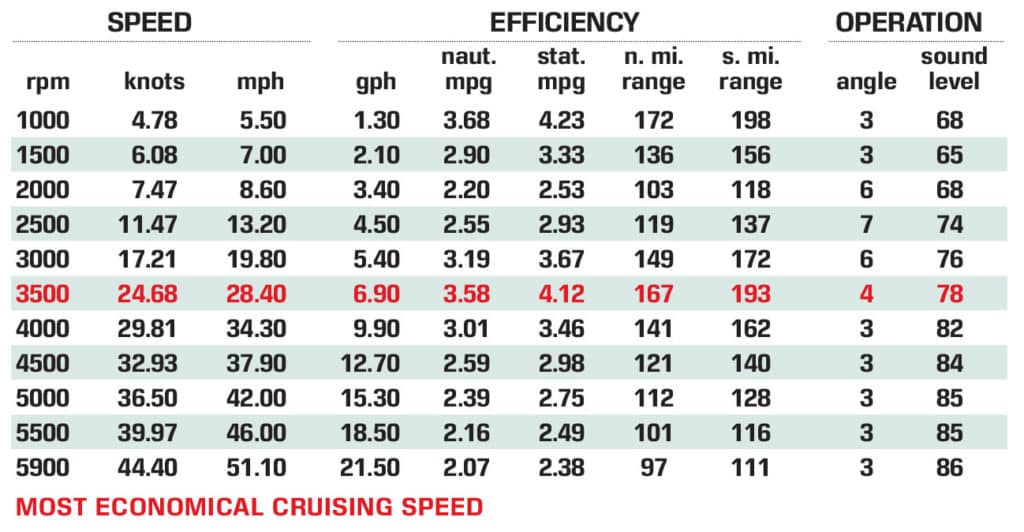
Sound
Does a Mercury Verado even make any noise? Turn the key and you’ll need to check the tachometer to tell if it’s running. It’s incredibly quiet, and because it’s so well-isolated from the boat, no sound or vibration can be resonated or amplified through the hull and deck. Recall that the decibel scale is a logarithmic ratio between two values—a sound 10 times greater in intensity will be measured as an additional 10 dB, and with an increase of just 3 dB, the sound intensity is doubled. So, when we measured 68 dB(A) at 1,000 rpm in the outboard boat and 71 dB(A) in the sterndrive boat, what appears to be a small difference is really noticeable—the sterndrive seems twice as loud to our ears. At 3,500 rpm, the outboard is 7 dB(A) quieter, and at 5,000 rpm, the difference is 10 dB(A). In the sterndrive boat, you can always hear the engine. In the outboard, what you hear is mostly wind and water.
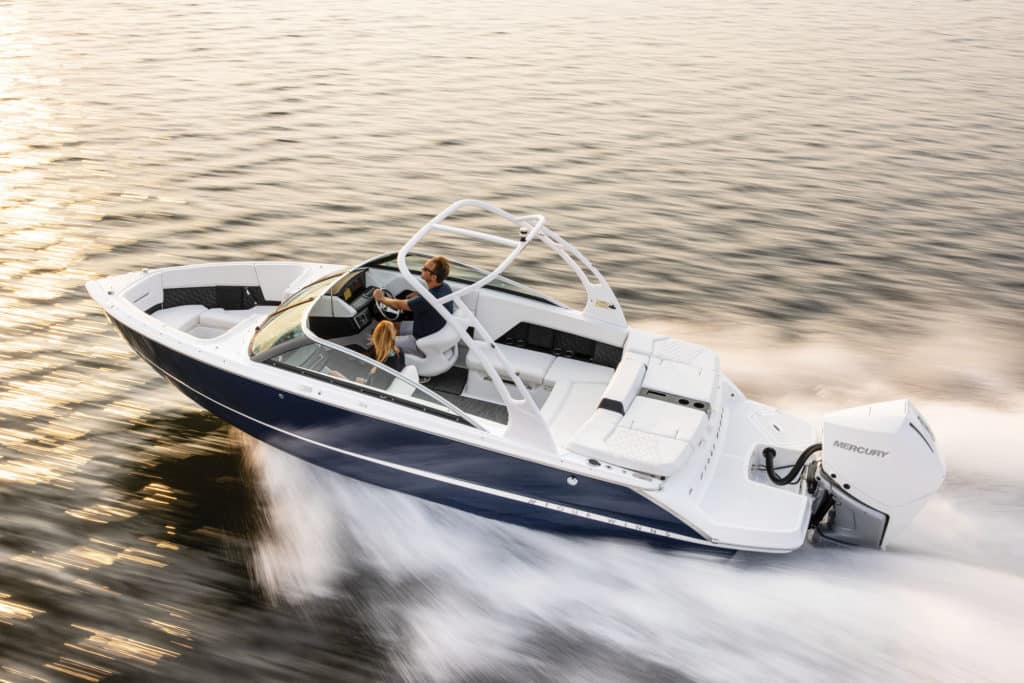
Boat Weight
At about 610 pounds, the Mercury Verado 250 weighs 293 pounds less than the Volvo Penta V6-280 and its Duoprop drive. However, when we weighed the actual test boats on the scales at the Four Winns test center, the outboard boat weighed 4,095 pounds—43 pounds more than the sterndrive. These boats were not identically optioned, and an aluminum tower added about 150 pounds to the weight of the outboard-powered H4 (and no doubt scrubbed a mile per hour or two of speed). The outboard boat also has a high-density polyethylene liner below its rear hatch (where the sterndrive engine would be), plus a pop-up canvas canopy assembly around the portable head stowed there and an electric lift for the seat base. This accounts for the rest of the weight difference between these two boats. Without the tower, the outboard boat would weigh less than the sterndrive, but only by perhaps 100 pounds. This points to not looking at engine power-to-weight ratios in isolation. Savvy boat shoppers should compare power output to total boat weight.
The Cockpit
When designing the H4 models, Four Winns could have moved back the aft cockpit seat to create more floor space in the outboard version. Instead, it chose to keep the aft seat in the same spot as on the sterndrive. This gives the outboard boat a sun lounge abaft the seat and a big stowage space below (about 48-by-36 inches and 25 inches deep), which can be outfitted with an optional portable head and canvas privacy curtain ($600). There’s no provision for the head on the sterndrive boat. The sun pad on the sterndrive boat is 30 inches deep, about 6 inches deeper than the pad on the outboard model. Forward of the rear seats, these boats are identical.
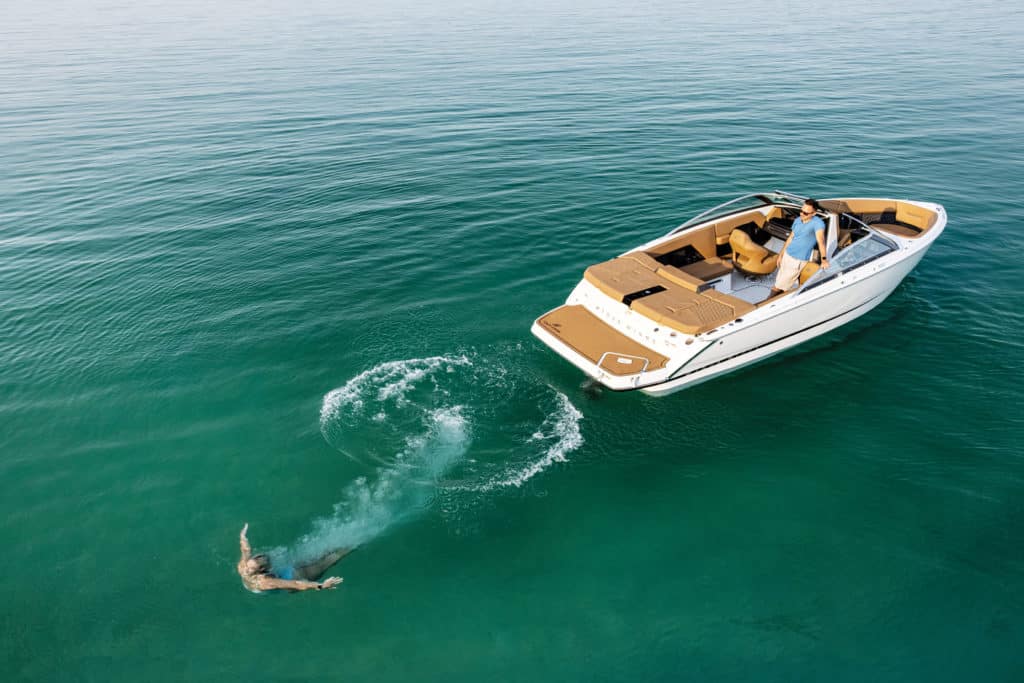
The Platform
Forget every other aspect of this comparison. According to the marketing mavens at Four Winns, for many runabout customers, having an outboard in the middle of the platform is simply a deal breaker. This boils down to aesthetics more than practicality. On both boats, the platform measures 6 feet, 8 inches wide and 2 feet, 6 inches deep. The outboard motorwell measures about 2 feet by 2 feet. There is still a good 6 inches of step space forward of the well, and the motor is set back enough that it’s not really an intrusion. However, some folks just can’t imagine sitting on the sun pad in the cove and having to look at that outboard like they were on Cousin Lenny’s bass boat. And in profile, it’s hard to argue that the sterndrive boat does not look sleeker.
Maintenance
Not a big difference here. Both engines should get oil and filters changed annually, and the oil change is probably a little easier with the outboard if you DIY. The outboard is self-draining, but thanks to closed-cooling, the Volvo Penta engine does not need to be pumped full of antifreeze for winterization. Simply drain the raw-water side of the cooling system and you’re done.
Surf’s Up!
Step up to a 300 hp or 350 hp engine from either MerCruiser or Volvo Penta, and you can order the Four Winns H4 with a forward-facing MerCruiser Bravo Four S or Volvo Penta Forward Drive, which places the props under the boat. Add the Surf Package ($11,236) for ballast bags and surf tabs, and grab your board. Your H4 is never a legal surf rig with outboard power.
Let’s sum things up. The outboard is significantly quieter than the sterndrive and provides faster acceleration and higher top speed, plus a lot more stowage space in the boat and the option of a portable head. The sterndrive offers somewhat better fuel economy than the outboard and a wide-open transom, and in this example, it costs about $9,000 less than the outboard. The wild card is the potential surfability of the sterndrive. These are both great boats—there’s a not a best version, just the best version for you.
How We Tested
Mercury Verado 250
- Claimed Horsepower: 250
- Engine Type: V-8
- Engine Displacement: 4.6L/279 CID
- Alternator Output: 115 amps
- Powertrain Weight: 610 lb.
- Boat Dry Weight: 4,095 lb.
- Weight as Tested: 5,217 lb.
- Top Speed: 51.1 mph
- Best Cruise: 4.1 mpg AT 3,500 rpm
- Time to Plane: 4.8 sec.
- 0 to 20 MPH: 4.1 sec.
- At 25 MPH: 4.0 mpg/79 dB(A)
- Base MSRP (with test power): $106,963
Volvo Penta V6-280C Duoprop
- Claimed Horsepower: 280
- Engine Type: V-6
- Engine Displacement: 4.3L/262 CID
- Alternator Output: 75 amps
- Powertrain Weight: 903 lb.
- Boat Dry Weight: 4,052 lb.
- Weight as Tested: 5,174 lb.
- Top Speed: 47.6 mph
- Best Cruise: 4.5 mpg at 3,000 rpm
- Time to Plane: 5.9 sec.
- 0 to 20 MPH: 6.3 sec.
- At 25 MPH: 4.3 mpg/85 dB(A)
- Base MSRP (with test power): $97,863

